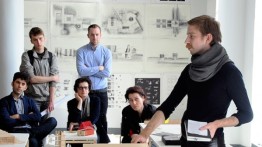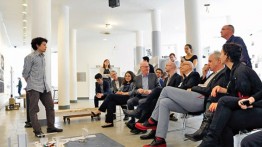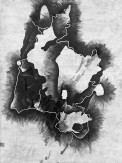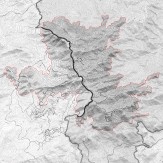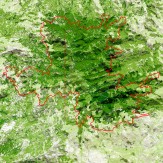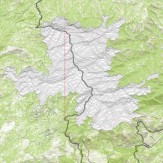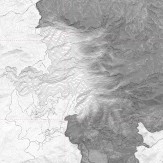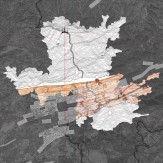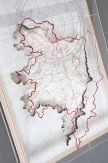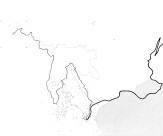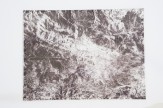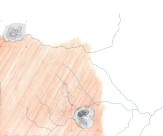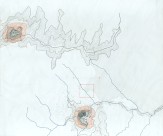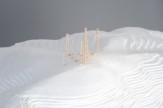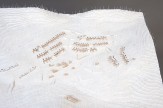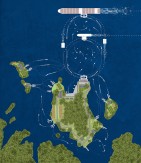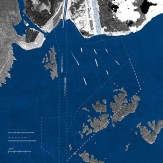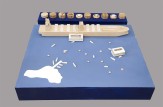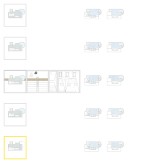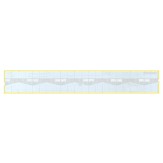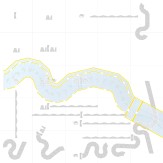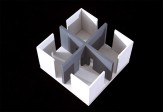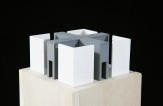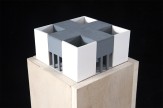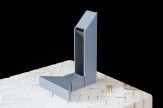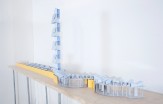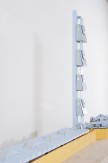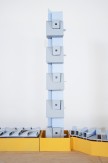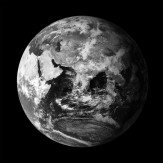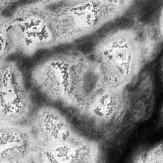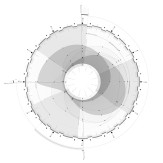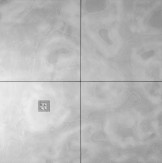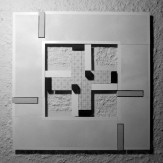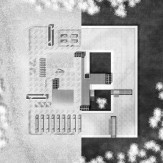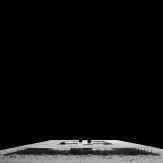Selected Undergraduate Design Studio Projects--Thesis 2013-14
THESIS
Professors David Turnbull, Pep Aviles, Hayley Eber, Cristina Goberna, Elizabetta Terragni & Theodore Kofman
May 2013. The Architecture School lobby was painted black, it was empty. We kept it that way. Standing in silence before moving to the Foundation Building’s first floor colonnade to talk about the School and about the work of the students, it was a review that was not quite a review, more of a rite of passage. A long table held carefully selected objects, drawings, books, projectors, maps and a square piece of turf bisected by a white painted line, two inches wide —two sides, home and away, them and us – positions taken. A simple confrontation. The end of an extraordinary year with remarkable students making exceptional work…. Former CIA employee and NSA contractor Edward Snowden flew to Hong Kong and the first documents released by Snowden to Guardian journalist Glenn Greenwald and filmmaker Laura Poitras, uncovering the existence of numerous global surveillance programs, were published. In Syria the death toll approached 100,000. Our students graduated. The End of Year Show opened. It was bright, full of life and hope, a testament to the creativity and vitality of the thesis class. But the school had changed and would change more significantly during the summer and throughout the fall.
September 2013. The thesis class entered this new Cooper Union, which appeared to be the same but was not. Charged with setting a goal for themselves and defining their own path through the year, they started with a short project called Messages & Messengers, an alibi perhaps, certainly a trick that would provoke a question, a thesis. In a world where uncertainty, anxiety, paranoia, fear, distrust and disbelief have almost comprehensively replaced any sense of comfort and security, with no firmness, too much commodity and only the most emaciated expression of delight, it comes as no surprise that the work this year tracks at least two paths, that might appear to be irreconcilable, but maybe are not: retreat and amelioration.
May 2014. Turning back the clock to a time of sense and sensibilities that were shared or looking forward to a new reality that is patched up, backed up and re-booted so that it will work better, more or less. Inevitably a third way is also apparent this year, an escape from the complication that comes with going backwards or forwards, as you never know quite what or who you might meet on the journey. This involves inventing some kind of parallel world, where like a bitcoin miner, the student architect plays complex games in an alternate reality to make things that actually have value in our reality. All three paths and the decision about the path to be taken raise questions about the autonomy, semi-autonomy or quasi-autonomy of our discipline. As ever, the ghosts whisper in the early hours and the best work reminds us that however confusing the world has become, inside and outside, however cacophonous the ambient noise, a still, clear voice can be heard that belongs to nobody but can be shared by everyone. Architecture.
Projects
-
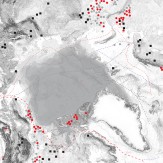
Navigating the Techno-Arctic
-

Cauterized Terrain
-
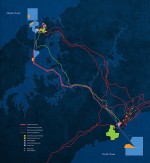
Free Trade Zone in Transit
-

Retreat
-
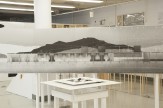
Knot - Brahmaputra River, India
Back
Navigating the Techno-Arctic
-

Arctic Sea ice shipping
-
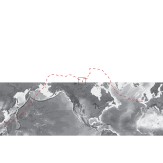
Halfway between
-

NW Passage Bathurst area
-
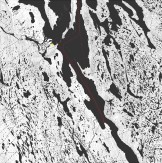
Inlet Sequence 1 through 6
-
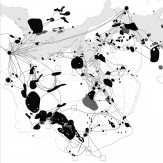
NW Passage Bathurst Network
-
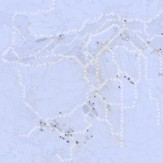
Beacons
-

Inlet Sequence 1 through 6
-
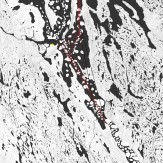
Inlet Sequence 1 through 6
-

Inlet Site
-

Humvee NW Passage
-

Land site winter
-

Land site elevation
-

Summer land site
-
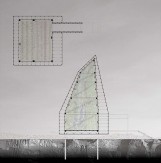
Plan and section
-
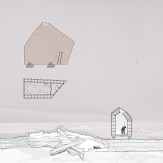
Plan and section
-

Freezer plan and section
-
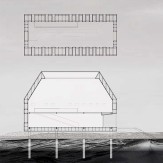
Plan and section
-
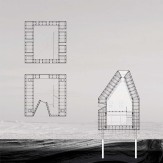
Plan and section
-

Summer land aerial
-
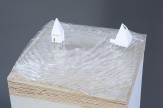
Model
-
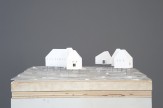
Model
-
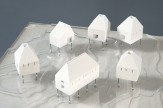
Model
-
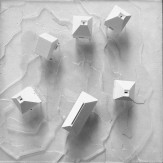
Model
William Hood
This project intends to confront the post-industrial transformation of natural landscapes through the implementation of networked and overlapping technological systems of organization. Using the Marconi Wireless Network as a precedent, the project initially analyzed the means by which wireless communication networks were created as connections between defined transmission stations. Each station was equipped with a radio antenna, a means to power the antenna, and employees to manage the signals. Yet, upon further development of communications technology, both the Marconi network in its early form, and the stations that served it, became obsolete and were disassembled. In present times only the tower pylons are left of these stations, as their ties to surrounding places were temporary and conditional only upon the internal operation of the transatlantic network.
My thesis is that a new relation between technology and landscape, based in the acknowledgment of local social and ecological frameworks, can counteract the rapid obsolescence that communication and navigational technologies face in their natural sites.
Projections of declining annual sea ice extents have made the Arctic Ocean the new frontier for global capitalism. In addition to plans to further map the frozen ocean’s floor and develop the navigational infrastructure for international shipping routes, several mineral extraction facilities have been begun exploration and production within the Arctic Circle. Though enabled by a warming climate, these large-scale organizations of transportation and production have neglected to work with the region’s omnipresent climatic conditions, and, similar to their industrial precedents, have failed to acknowledge their intersection with local cultural conditions, especially Inuit lifestyles that remain based on hunting and fishing. As an alternative response to these tendencies, this project proposes a new process for the conversion of the natural to the man-made through the interweaving of disparate cultural forces in order to resist depletion and obsolescence.
Along these lines, a shared system of navigation and resource production will be created. Mineral extraction infrastructures will be re-programmed and channeled into existing migration networks to double as floe edge beacons and seasonal stations for hunters, miners, fishermen, and the occasional researcher. Thus, the architecture is embedded in the reorganization of the territory’s technological systems and is manifest physically at the specific moments of their confluence.
Cauterized Terrain
Harry Murzyn
Wildfire reveals the transition between death and rebirth: its boundary is a spatial threshold delineating that which has been purified by flame and that which has not. This perimeter scar is a fleeting remnant of the radical atmospheric landscape of fire: a complex environmental interplay of weather, topography, fuels, and human intervention.
This thesis questions the permanence of architecture by reconsidering its relationship to fire. The target is to reconcile architecture, formally and programmatically, with the cycles of decay and reinvention that characterize the long passage of time rather than allowing it to become an ignorant obsolete: a ruin. And so here I propose a new city form to facilitate and register the continual rebirth of place.
Sprawled settlement patterns have been transplanted into the forest while assuming detachment from its natural processes. And so with each fire, the settlers inscribe a line on the ground. This line marks the singular human trek through the forest connecting the fire’s origin and end, a ritual of containment, but of that which cannot be contained. Inevitably, a sacrificial loss accompanies this ritual: of resources, of environment, and often of life. We have chosen how to live; nature dictates on what terms.
The natural fire regime of the forest must be restored, and the new city must coexist with its processes of purification. Around the historical core of Crown King, the community will be rebuilt as a gradation of architectural thresholds, actively engaging the spread of flame. The thresholds take on the program of plateau, house, and passage. At the perimeter, a new ritual is enacted: a periodic burning—the tempering of the city by fire.
Free Trade Zone in Transit
Andrew Lam
Once the most important trading route that connected the Atlantic and Pacific Ocean, the Panama Canal, endured a history of political and cultural strife that specifically dealt with the autonomous control of the waterway between the Republic of Panama and the United States of America. More than a decade later, after the handover of the canal back to Panama, the country is now facing a new shift in global interests. With the growing economical demand of the international community, the size of container ships has redefined the ownership of the Panama Canal; as a canal belonging to the world. My project deals with the internal workings of the Panama Canal as well as the growth in container vessels, as a way to create a new urbanism which involves the use of boats and floating programmatic spaces. It will be a community created on the basis of trade and interaction between the vessels and boats, and also a way to urbanize areas where activity is stagnant.
Retreat
Eduardo Alfonso
“It was the intensity of their vision coupled with their isolation in the wilderness, that caused them one and all to place on the canvas veritable capsules, surrounded by a line of color, to hold them off from a world which was most about them.”
William Carlos Williams —“Painting in the American Grain”
Rather than continuing the rhetoric of urban expansion by proposing another master plan, this project takes the form of a retreat. A retreat is a line: it holds things in and out. It moves away from one mode towards another, but does not try to define a new orthodoxy. Its inhabitation is temporary and its forms are fragmentary. It acknowledges that spatial scenarios within the city that are entropic have the potential to provide a scene in which to redefine inhabitation. This scenario within the contemporary city can be reframed as a (new form of) wilderness, in which inhabitation and social configuration can also become entropic.
Exploration of these themes began with studies of religious societies and pioneering efforts that existed along the shifting border of the United States. These societies, which included the Shakers, the Moravians, the Rappites, the Owenites, and the True Perfectionists, were investigated not for their theological and eschatological systems as such, but rather for their desire to invert architectural typologies and hierarchies in order to seek new possibilities within the logic of domestic space. In these communitarian societies, notions of public versus private and individual versus common are in a continuous process of redefinition. This redefinition could only take place within the logic of the wilderness. This research culminated in a visit to multiple historic sites which had been inhabited by these radical groups.
The project’s tectonic arose from re-figuring the conditions discovered in the case studies. The Retreat is composed of a series of houses, which are each made for a set number of inhabitants. The number of inhabitants in the retreat community is also always kept prime. As such, the houses are set for 3, 5, 11, 23, and 1. The arithmetic logic of prime numbers dictates that a 1 house be added to connect any other two houses, so that the inhabitants of the community are always kept odd (Ex: 23+5= 28 +1=29). The rhetoric of primes and odds moves The Retreat community away from the static association of even numbers and couplings, keeping the number of inhabitants incomplete and fragmented. The houses can aggregate, and their plan conditions allow that all the parts to a (never complete) whole form a continuous corridor of sleeping rooms. This enfilade condition makes tacit the entropic condition of the wilderness and holds out the metropolis, where normalized living based on speculation extends into sites that have the potential to provide an experimental ground for inhabitation.
Knot - Brahmaputra River, India
Mark Tugman
How might the relationship between the rural population of Assam, India and the environment become a driver for social and political freedom? This question requires us to see the environment not as a source of tyranny or the picturesque, but as a process by which social identities are formed. First, we must redefine the word ‘environment’ from a noun to a verb. The environment does not merely symbolize relationships of power and social hierarchies; it actively sustains them, it naturalizes them, and by doing so, it has the capacity to challenge them.
In framing this investigation, it was necessary to draw on the environment with regard to its role in cultural history, social practices, rituals, law making, food production, water supply, shelter, sanitation, and education. It is becoming increasingly evident that the global social constructs of the nation state, capitalism, and sustainability are unable to recognize the crises of marginalization occurring at geopolitical borderlands such as the banks of Brahmaputra. Instead, the expansion of individual freedom and collective agency should be both the primary end as well as the principle means of development.
The implementation of this thesis begins with a critique of the rigid ideology of the embankment to develop new relationships with the Brahmaputra’s sediment load. It uses the results of this critique to drive the development of social institutions that can operate on the contemporary knot of colonialism, capitalism, and sustainability. Through their location in the river, these social institutions can operate simultaneously from within and outside of the capitalist structures of property. Embracing the ambiguous thresholds between land and water can create spaces to critique and challenge, in theory and in actual prototype, the relationships between the villages and the river, their agricultural landscape, and their geopolitical location in the fastest growing democracy in the world. By working in reciprocity with naturally occurring processes, an economy of survival can be transformed into a dynamic economy based on empowerment.

